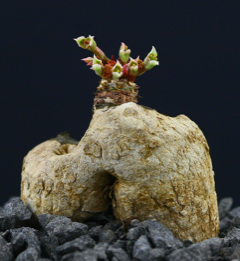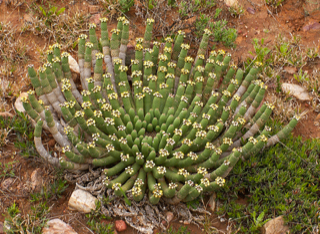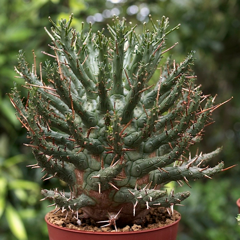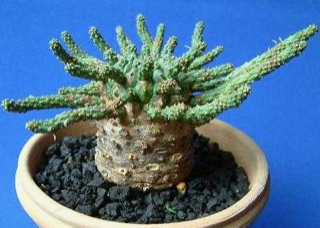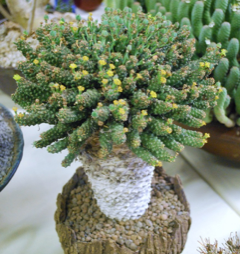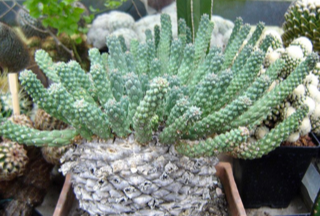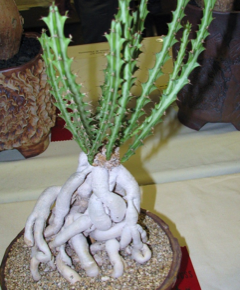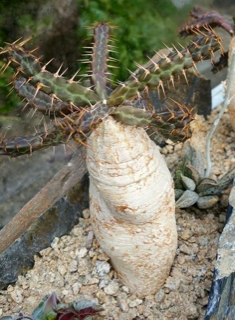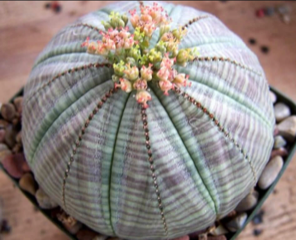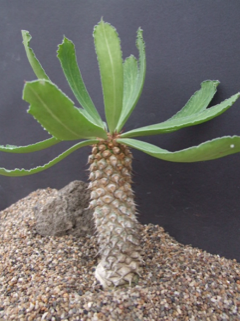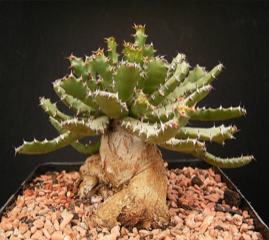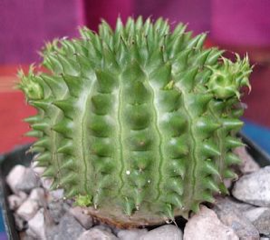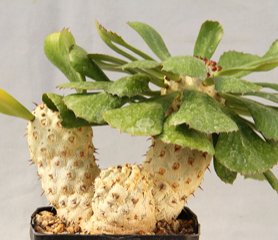Submitted by: Jim Tanner
Euphorbia is one of the largest of the succulent plant families. The genus Euphorbia is found throughout the tropics and semi tropics around the world, with some members of the family growing well into temperate regions. The succulent species are largely African and Madagascan, although there are some interesting and rarely seen species from the Americas. Given the size of the African continent, and the distribution of interesting Euphorbias from the northernmost parts to the tip of the Cape, it is hard to make any sort of generalization on cultivation.
When buying a Euphorbia it is a good idea to find out where it comes from. Species native to the South Africa or Namibia are generally fairly easy to grow. Their natural environment is not that different from Southern California. It is best to ascertain whether they come from a winter or summer rainfall area, and treat them accordingly. Most are summer growers but there are exceptions.
The sap of many Euphorbias is toxic and an irritant. Care needs to be taken when handling the plant and eye protection should be worn when cutting into the plants, particularly in the spring when sap is sometimes under pressure. Careful attention to washing up after working on Euphorbias will avoid most problems.
Euphorbia gymnocalycioides found in Ethiopia and Somalia is a good example of a tropical species. Relatively difficult on is own roots, it is usually seen as a grafted plant.
Euphorbia gorgonis is a good example of a medusoid from the Eastern Cape of South Africa. Coming from an environment very similar to Southern California it is easy to grow, requiring only some protection from winter rains, and doing best in a very open potting mix.
Euphorbia squarrosa, also from the Eastern Cape is a great example of a caudiciform Euphorbia. One of the easiest to grow, it makes an impressive specimen from cuttings in just a few years.
From the Western Cape a summer rainfall area, is Euphorbia suzannae. This is a great example of a stem succulent Euphorbia.
Tom Glavich
[Ed: Also see excellent articles by Geoff Stein “Introduction to the Medusoid Euphorbias” and “Cold Hardy Euphorbias- the small globoid to columnar species“]
LATIN LOOKUP – Loquerisne Latine (Do you speak Latin)?
The meanings of latin plant names on this page – from http://davesgarden.com/guides/botanary/
- brunellii [broo-NEL-lee-eye]
For 20th century Swedish botanist H. E. Brunell. - Euphorbia [yoo-FOR-bee-uh]
Named for Euphorbus, Greek physician to Juba II, King of Mauretania. - flanaganii [flan-uh-GAN-ee-eye]
Named for Henry George Flanagan, 19th century South African-born plant collector. - fortuita [for-TOO-ih-tuh]
From the Latin, meaning happening by chance, accidental. - gorgonis [gor-GOH-nis]
1. Of the Gorgon, from Greek mythology; for the medusoid growth form.
2. Of or from Gorgona Island, Italy. - micracantha [myk-ruh-KAN-tha]
From the Greek mikros (small) and anthos (flower). - obesa [oh-BEE-suh]
Fat. - poissonii [poy-SON-ee-eye]
For Eugene A. Poisson, 20th century French traveller, naturalist and government agent in West Africa. - squarrosa [skwa-RO-suh]
1. Having scales or scale-like overlapping leaves or bracts.
2. With parts spreading or recurved at the ends. - suzannae [soo-SAN-ay-ee]
Variant of susannae; named for Susanna (or Suzanna) Muir, wife of John Muir, 19th century Scottish born American naturalist and explorer. - unispina [un-ee-SPIN-a]
Single-spined.
